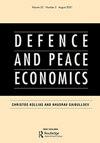国家建设与和平协定执行
IF 1.6
3区 经济学
Q2 ECONOMICS
引用次数: 0
摘要
人们经常认为,在州内冲突后重建国家能力将有助于稳定冲突后的环境。过去的学术研究试图正式模拟国家能力上升的影响。然而,冲突后环境的两种模式对国家能力对承诺问题的影响和执行和平协议的前景产生了相互矛盾的期望。该项目总结了这两个模型的核心逻辑,比较和对比了它们的假设,并得出了一套关于执行和平协议的假设。这些假设是用《和平协定》矩阵中的数据进行检验的。实证结果表明,军事能力的提高与和平协议执行水平的降低有关。然而,国家法治能力的提高与更高的执行水平有关。强制和行政能力的起始水平似乎与和平协定的执行程度无关。这一发现为和平协议破裂提供了可能的早期预警。同样,它表明,国家建设与其说是冲突后成功的驱动力,不如说是关键行为者偏好的体现。本文章由计算机程序翻译,如有差异,请以英文原文为准。
State Building and Peace Agreement Implementation
ABSTRACT It is often argued that rebuilding state capacity following intrastate conflict will serve to stabilize the post-conflict environment. Past scholarship has sought to formally model the effect of rising state capacity. Yet, two models of post-conflict environments produce conflicting expectations for the effect of state capacity on the commitment problem and the prospect for peace agreement implementation. This project summarizes the core logic of the two models, compares and contrasts their assumptions, and derives a set of hypotheses about the implementation of peace agreements. These hypotheses are tested using data from the Peace Accords Matrix. The empirical findings indicate that increases in military capacity are associated with lower levels of peace agreement implementation. However, increases in state capacity related to the rule of law are associated with higher levels of implementation. The starting level of coercive and administrative capacity appears to be uncorrelated with the degree to which peace agreements are implemented. This finding points to a possible early warning for peace agreement breakdown. Likewise, it suggests that state building may be less a driver of post-conflict success than it is a manifestation of the preferences of key actors.
求助全文
通过发布文献求助,成功后即可免费获取论文全文。
去求助
来源期刊

Defence and Peace Economics
ECONOMICS-
CiteScore
4.00
自引率
18.80%
发文量
45
期刊介绍:
Defence and Peace Economics embraces all aspects of the economics of defence, disarmament, conversion and peace. Examples include the study of alliances and burden-sharing; military spending in developed and developing nations; arms races; terrorism; country surveys; the impact of disarmament on employment and unemployment; the prospects for conversion and the role of public policy in assisting the transition; the costs and benefits of arms control regimes; the arms trade; economic sanctions; the role of the United Nations.
 求助内容:
求助内容: 应助结果提醒方式:
应助结果提醒方式:


